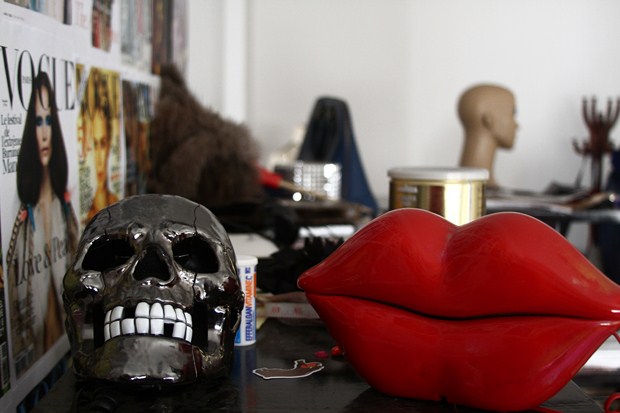A Story by Megan Cécile Radford
photos: Rabii Kalboussi
Walking into Seyf Dean Laouiti’s accessories atelier in Tunis, I feel a bit like Alice falling down the rabbit’s hole. Shoes, jewelry, books, and various knick-knacks are stacked on shelves, tables and a sewing stand. Spilling out of a bag are pieces from Laouiti’’s new collection, fresh from a recent photo-shoot for his magazine, FFDesigner. A box of rosettes sits on one desk, a skull ash tray on another, and a lip-shaped telephone on a shelf. It’s like a grown-up playroom, and Laouiti (with his spike-adorned top-hat) is the Mad Hatter and creator-in-chief.
“People express themselves with words, I express myself with fashion,” he says.
Dressed in a button-up shirt with a ribbon for a bow-tie, jeans, bright blue shoes, and contact lenses that turn his eyes a piercing cobalt, Laouiti doesn’t look like your average Tunisian. But that’s because he isn’t. His mother is Taiwanese, his father Tunisian, making Laouiti himself a jumble of cultures. He has lived in six different countries and speaks four different languages. He has contacts with Fashion’s Night Out in Beijing, and Vogue covers from around the world adorn the wall behind his desk. But It’s Tunisia that he’s set his sights on, and for now at least, this is where he will stay.
“It’s a new territory for fashion/ It’s still in virgin territory. Even if I was not Tunisian at all, and I saw the opportunity to develop the fashion industry in Tunisia, I would do it immediately.”
Laouiti was away on exchange in Asia during the Revolution. Now that he is back, he isn’t wasting any time. This Fashion Week Tunis he presented his first ever full collection under the name Narciso Domingo Machiavelli. It was a smash hit. By the time red confetti exploded from the balcony with the last gown, the audience was wild.
Each outfit was crafted from lace, rosettes and richly feminine colours like red, navy and pink. Black also featured prominently, and contrasted the bright red roses in the models’ hair. It was a playful collection that referenced Laouiti’s favourite designers, like Alexander McQueen and Marchesa. But the skulls on a sweet pink bustier dress, the spikes on the stilettos and the hand-crafted rosette fabric were all Laouiti’s own.
“The absurd is my signature,” he says, referring to his unique touches. “It always comes from a story.”
His show also stood out because of a tape playing behind the sophisticated soundtrack. On it, Laouiti’s voice was heard describing his creative process, and musing about the things that inspire him, like his simple no. 2 pencil.
For Laouiti, Fashion Week was a step towards recognition, but he says he’d rather people remember the name of his brand, Narciso Domingo Machiavelli, than his own. He wants to make something that lasts, and one part of that is working with other creators on a publication called FFDesigner.
“The magazine is to help people see that you can actually wear things from the runway,” he explains.
Laouiti began his magazine during his studies at Esmod fashion school, and is in the final stages of moving it from a facebook page to online and print platforms. He uses clothes from Tunisian designers and styles them into elaborate fashion shoots, also profiling young creatives, and tips on the latest trends. “It’s like a support group for fashion,” he jokes. Laouiti created FFDesigner to highlight Tunisian talent and support Tunisians who are interested in fashion. “They should have their shot,” he maintains, referring to the designers, photographers, artists, musicians and writers he will feature on FFDesigner’s pages.
In the midst of all this, Laouiti has become a part of building a community of young Tunisian talent in the form of models, designers, photographers, journalists, musicians and artists. On weekends you can find them at one of Tunis’ hotspots, dancing and planning their next venture. People orbit like planets around Laouiti and the other designers, hoping to get a chance to wish him well, and congratulate him on his collection.
Despite his rising popularity, Laouiti remains a passionate dreamer, if not exactly down to earth, than still more concerned with the creative process than with fame. He describes how he has trouble sleeping because of the constant barrage of ideas, projects, and to-do lists. But he’s young, he smiles, and there is no way he’s slowing down. His next moves are to find a charity that he can lend his creative juices to, possibly to design t-shirts and sell them for a good cause. He is also discussing ways that he and his friends can incorporate traditional Tunisian artisans into their clothes. Recently he participated in creating an art piece for Chkoun Ahna, an art exhibit at Carthage Museum. He and others sewed scores of tiny jasmine flowers onto black fabric to create Tunisian artist Nadia Kaabi-Linke’s version of the Salafist flag. Participating in cultural projects like these seems to be his signature career move, and helping young Tunisians and charities along the way is only natural.
“What are we doing here on earth? I think it’s to help people,” he concludes.





